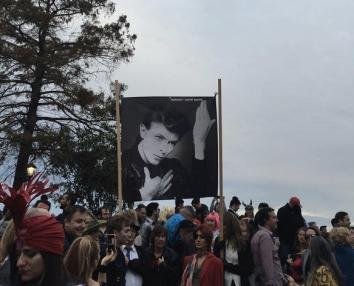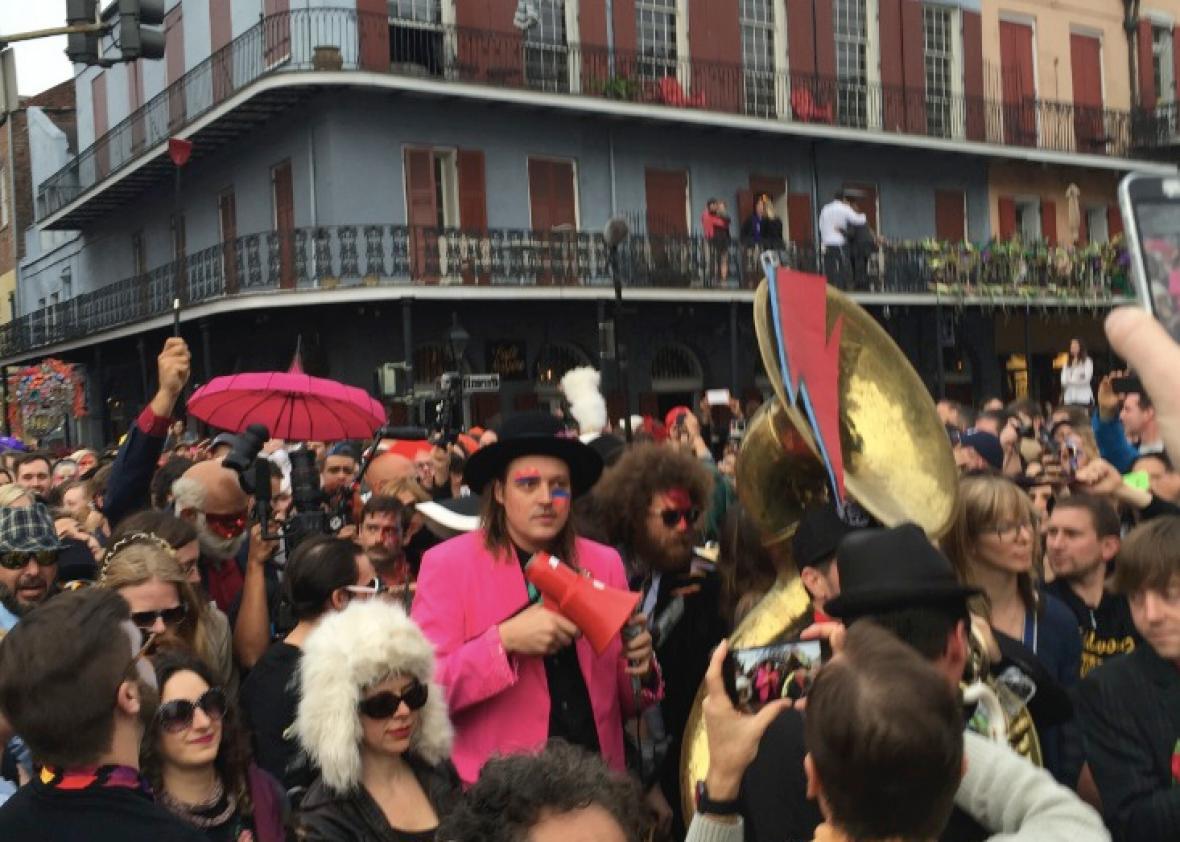As I paid for metered parking just off the French Quarter in New Orleans Saturday I thought of an article I had read in the New York Times that morning. The city’s cash-starved public defenders office, which recently announced it would refuse some felony cases, is—absurdly—greatly supported by parking ticket fees. If I don’t make it back in time from the David Bowie memorial parade, I thought, at least someone will get fifteen minutes of legal aid.
New Orleans may not do government particularly well, and the class divide here gapes like a sinkhole, but this city mourns the dead like no other, intertwining sadness and celebration seamlessly. When you walk in a second line, it sometimes feels as if the ghost of the deceased hovers above, watching. What would David Bowie had thought of this spectacle?
The parade—not officially a second line parade as it wasn’t thrown by a social aid and pleasure club—was put together at the last minute by the Preservation Hall Jazz Band and Arcade Fire’s new-ish New Orleans residents Win Butler and Régine Chassagne. It was a testament to the lasting influence of Bowie, at the very least visually. Pink and blue lightning bolts decorated faces everywhere, or gold circles painted dead center on foreheads. Men in space suits, women in Bowie drag, mod suits, shag wigs. Drag, drag, drag everywhere, but then again Bowie was the drag queen and king.
Win Butler, smiling, in a black hat and stunning fuchsia suit, spoke to the crowd from the balcony of the Preservation Jazz Hall. “This is a way to express the deep gratitude we had that he existed,” he said. Then, thousands of people marched following the band through the crowd-lined streets. Butler sang-spoke Bowie lyrics through a megaphone. “Is it any wonder,” I heard him say, quoting “Fame,” and it felt like a song all its own.

Photo by Jami Attenberg
Not everyone was there out of a deep connection to the man’s music. “Labyrinth was one of my favorite childhood movies,” a woman in a full gold lamé body suit and Bowie shag wig and lightning-bolted cheek told me. “That’s about it. But I’m from New Orleans, we don’t need much of a push to dress up here.” She added, “Plus when do you ever get to second line with Arcade Fire?” I saw more than a few people—all of them in their 40s and 50s, the age of blooming mortality fears—dressed as Bowie in his final video for “Lazarus,” a simple cloth as a death mask, beads for eyes, silently, peacefully, they walked. Those moments of sober contemplation came as a relief to all the glitter and glam in the crowd. When the parade hit the river I looked back and saw posters of a younger Bowie raised high above the crowd. There you are, I thought. I missed your face.
Then I passed a small crowd chanting, “She said yes.” A man named Emile had just proposed to a woman named Megan. Her ring was made of a small pearl that he had found in the first oyster po’ boy he had ever eaten in New Orleans. A pink and blue lightning bolt ran across her face. “I only had to do a touch-up on it,” she said. “I still had it on from last night.” She had been doing a practice run on her costume for the Krewe du Vieux Mardi Gras parade the following weekend. Is it any wonder, I thought.
Read more in Slate about David Bowie.
